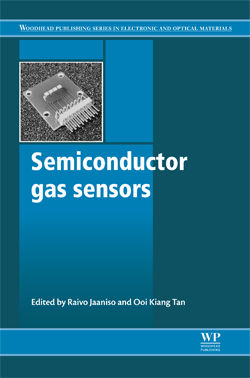| 
索书号 TP212.2/J11
Contents
PART 1 INTRODUCTION
Fundamentals of semiconductor gas sensors
N Yamazoe and K Shimanoe, Kyushu University, Japan
- Introduction
- Classification of semiconductor gas sensors
- Resistor type sensors (1) Empirical aspects
- Resistor type sensors (2) Theoretical aspects
- Non-resistive sensors
- Future trends
- References
Conduction mechanism in semiconducting metal oxide sensing films: impact on transduction
N Barsan, M Huebner & U Weimar, University of Tuebingen, Germany
- Introduction
- General discussion about the sensing with SMOX gas sensors
- Sensing and transduction for p- and n-type semiconducting metal-oxides
- Investigations of the conduction mechanism in SMOX sensing layers: “operando” studies
- Conclusion and future trends
- References
Electrode materials and electrode-oxide interfaces in semiconductor gas sensors
S P Lee, Kyungnam University, Korea
- Introduction
- Electrode materials for semiconductor gas sensors
- Electrode-oxide semiconductor interfaces
- Charge carrier transport in the electrode-oxide semiconductor interfaces
- Gas/solid interactions in the electrode-oxide semiconductor interfaces
- Conclusion
- References
PART 2 ADVANCED SENSING METHODS AND STRUCTURES
Recent trends in Silicon Carbide (SiC) and Graphene based gas sensors
A Lloyd Spetz and MAndersson, Linköping University, Sweden, and R Pearce, Linköping University, Sweden, and National Physical Laboratory, UK
- Introduction
- Background: transduction and sensing mechanisms
- Recent material developments for SiC and graphene based gas sensors
- Dynamic sensor operation
- Novel SiC and graphene based sensor devices
- Conclusion
- References
Recent advances in wide bandgap semiconductor based gas sensors
F Ren and S J Pearton, University of Florida, USA
- Introduction
- Gas Sensing
- Hydrogen Sensing
- GaN Schottky Diode Sensor
- Nanostructured Wide Bandgap Materials
- SiC Schottky Diode Hydrogen Sensor
- Wireless Sensor Network Development
- Conclusion
- Acknowledgments
- References
Micromachined semiconductor gas sensors
D Briand, Ecole Polytechnique Fédérale de Lausanne, Switzerland, and J Courbat, Innovative Sensor Technology IST AG, Switzerland
- Introduction
- A brief history of semiconductors as gas sensitive devices
- Micro-hotplate concept and technologies
- Micromachined metal-oxide gas sensors
- CMOS compatible metal-oxide gas sensors
- Micromachined field-effect gas sensors
- Trends and perspectives
- Conclusion
- References
Semiconducting direct thermoelectric gas sensors
R Moos and F Rettig, University of Bayreuth, Germany
- Introduction
- Direct thermoelectric gas sensors
- Conclusion and future trends
- References
PART 3 NANOMATERIALS FOR GAS SENSING
One- and two-dimensional metal oxide nanostructures for chemical sensing
E Comini, Brescia University, Italy
- Introduction
- Deposition techniques
- Conductometric sensor
- Transduction principles and related novel devices
- Conclusion and future trends
- References
Semiconductor quantum dots for photoluminescence based gas sensing
Z Zhao, M A Carpenter, and M A Petrukhina, University at Albany-SUNY, USA
- Introduction
- Quantum dot synthesis, surface functionalization and polymer encapsulation
- Quantum dots for sensing – dependence of detection limits and selectivity on surface modifying ligands
- QD-polymer system
- QD-nanopore array system
- Conclusion and future trends
- Acknowledgments
- References
Coated and functionalised single-walled carbon nanotubes (SWCNTs) as gas sensors
Y Battie, Université de Lorraine, France, and O Ducloux, ONERA, France
- Introduction
- Gas sensor architecture
- Gas sensing mechanisms
- Routes toward the sensor selectivity
- Applications
- Conclusion
- References
Carbon nanotube and metal oxide hybrid materials for gas sensing
T Kerdcharoen, Mahidol University, Thailand and C Wongchoosuk, Kasetsart University, Thailand
- Introduction
- Fabrication and synthesis of carbon nanotube – metal oxide sensing devices
- Preparation of carbon nanotube – metal oxide sensing films
- Sensor assembly
- Characterization of carbon nanotube – metal oxide materials
- Sensing mechanism of carbon nanotube – metal oxide gas sensors
- References
Porous silicon gas sensors
V M Aroutiounian, Yerevan State University, Armenia
- Introduction
- Conductivity and capacitance sensors
- Luminescence from Psi
- Optical and photo properties of Psi sensors
- Psi noise sensors
- Different Psi gas sensors
- Conclusion
- References
PART 4 APPLICATIONS OF SEMICONDUCTOR GAS SENSORS
Metal oxide semiconductor gas sensors in environmental monitoring
R Binions, University of London and A J T Naik, University College London, UK
- Introduction
- Sensor synthesis methods
- MOS in detecting environmentally important gases
- Advances in carbon monoxide sensors
- Advances in carbon dioxide sensors
- Advances in nitrogen oxides sensors
- Future trends
- Conclusion
- Sources of further information and advice
- References
Semiconductor gas sensors for chemical warfare agents
D-D Lee and J-C Kim, Kyungpook National University, Korea
- Introduction
- Chemical warfare agents
- CWA detecting techniques
- Device Preparation
- Sensing Properties
- Conclusion
- References
Integrated complementary metal oxide semiconductor-based sensors for gas and odour detection
P K Guha and S Santra, Indian Institute of Technology, India and J W Gardner, University of Warwick, UK
- Introduction
- Micro-resistive CMOS gas sensors
- Micro-calorimetric CMOS gas sensor
- Sensing materials and their deposition on CMOS gas sensors
- Interface circuitry and its integration
- Integrated Multi-Sensor and Sensor Array Systems
- Conclusion and future trends
- References
Solid-state sensors for carbon dioxide detection
G G Mandayo, CEIT-Ik4 and Tecnun, Spain and J Herrán,, Cidetec-IK4, Spain
- Introduction
- Electrochemical sensors
- Impedimetric, capacitive and resistive sensors
- Field effect transistor sensors
- New approaches to enhance sensors performance
- Conclusion and future trends
- References
|